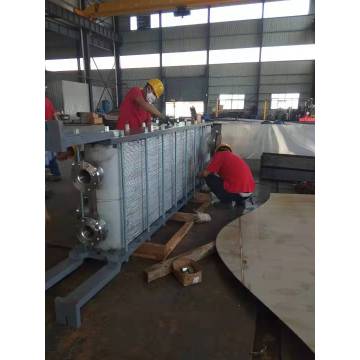
1. Electrode arc welding
Welding rod arc welding is a process that uses a stable burning arc established between the welding rod and the workpiece to melt the welding rod and the workpiece to obtain a strong welding joint. During the welding process, the coating continuously decomposes and melts to generate gas and slag, protecting the end of the welding rod, the arc, the molten pool and its surrounding areas, and preventing harmful pollution of the molten metal from the atmosphere. The core of the welding rod also continuously melts under the action of arc heat, enters the molten pool, and forms the filler metal of the weld.
2. Submerged arc welding
Submerged arc welding (including submerged arc surfacing and electroslag surfacing, etc.) is a method in which the arc burns under the flux layer for welding. Its inherent advantages of stable welding quality, high welding productivity, no arc light, and little smoke make it the main welding method in the production of important steel structures such as pressure vessels, pipe sections, and box beams and columns.
3.Argon arc welding
Argon arc welding is a welding technology that uses argon as a protective gas. Also called argon gas shielded welding. It is to pass argon protective gas around the arc welding to isolate the air from the welding area and prevent oxidation of the welding area.
Argon arc welding technology is based on the principle of ordinary arc welding, using argon gas to protect metal welding materials, and using high current to melt the welding materials into a liquid state on the base material to be welded to form a molten pool, so that the metal to be welded and the welding material are A welding technology that achieves metallurgical bonding of materials. Since argon gas is continuously supplied during high-temperature molten welding, the welding material cannot come into contact with oxygen in the air, thus preventing the oxidation of the welding material. Therefore, stainless steel and iron hardware metals can be welded .
4. Gas welding
oxygen fuel gas welding (OFW for short). A welding method that uses the flame generated by the mixed combustion of combustible gas and combustion-supporting gas as a heat source to melt the weldment and welding materials to achieve interatomic bonding. The combustion-supporting gas is mainly oxygen, and the combustible gas mainly uses acetylene, liquefied petroleum gas, etc.
5.Laser welding
Laser welding is a method of welding using the heat generated by bombarding the weldment with a focused laser beam as an energy source. Because laser has optical properties such as refraction and focusing, laser welding is very suitable for welding micro parts and parts with poor accessibility. Laser welding also has the characteristics of low heat input, small welding deformation, and is not affected by electromagnetic fields.
Due to the expensive price of lasers and low electro-optical conversion efficiency, laser welding has not been widely used.
6. C
arbon dioxide gas shielded welding Carbon dioxide gas shielded welding process is suitable for the welding of various large-scale steel structures of low carbon steel and low alloy high-strength steel. It has high welding productivity, good crack resistance, small welding deformation, and can adapt to a wide range of deformation. Welding thin and medium-thick plates.
7. Friction welding
Friction welding refers to a method of welding by using the heat generated by friction on the contact surface of the workpiece as a heat source to cause plastic deformation of the workpiece under pressure.
Under the action of pressure, under the action of constant or increasing pressure and torque, the relative motion between the welding contact end surfaces is used to generate friction heat and plastic deformation heat on the friction surface and its nearby areas, causing the temperature of the friction surface and its nearby areas to rise to In the temperature range close to but generally lower than the melting point, the deformation resistance of the material decreases, the plasticity increases, and the oxide film at the interface is broken. Under the action of the upsetting pressure, the material undergoes plastic deformation and flow, and occurs through molecular diffusion and recrystallization at the interface. Solid state welding method to achieve welding.
8. Ultrasonic welding
Ultrasonic welding uses high-frequency vibration waves to transmit to the surfaces of two objects to be welded. Under pressure, the surfaces of the two objects rub against each other to form fusion between the molecular layers.
9.Soft soldering
Soldering is a type of connection method that uses solder with a melting point not exceeding 450°C and is heated to a soldering temperature that is lower than the melting point of the base metal and higher than the melting point of the solder. The solder is spread on the closely fitting connection surface by capillary action or on the workpiece surface by wetting.
Solder is a solder material whose liquidus temperature (melting point) does not exceed 450°C. Solder is usually an alloy that does not contain iron. The temperature of 450°C is the dividing point between brazing and soldering. Most of the process parameters and influencing factors involved in brazing are also applicable to soft soldering. In fact, industrial terms such as soldering, brazing or silver soldering are also used to distinguish between soft soldering and brazing.
10.Brazing
Brazing is a high-temperature brazing process. Most brazing temperatures are between 1200 and 1400F° (much higher than soft soldering, but much lower than fusion welding). Like soft soldering, brazing relies on capillary action to fill the joint with solder. There are many different types of braze alloys that can be used to weld almost any kind of metal or metal alloy.

![]() December 04, 2023
December 04, 2023 1. Electrode arc welding
1. Electrode arc welding



